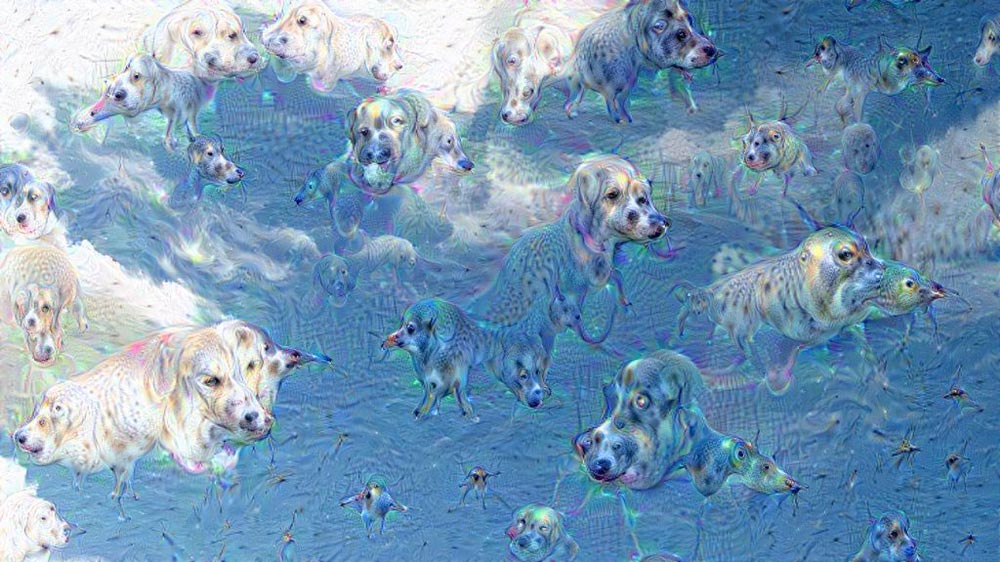cloud_dalmatin_argmax - “101”, 2015
“Looking at the Clouds” is a series of artworks created by Alexander Mordvintsev in July 2015, soon after the publication of the DeepDream algorithm. DeepDream explored the uncharted territory of machine perception. Inception network that was trained only to recognize images (with some bias towards dog breeds), surprisingly possessed latent generative capabilities when executed in a specific manner. In a way, this foreshadowed the "prompting" phenomenon that has since captivated the world, where the vast potential of models trained on massive datasets can be unlocked by querying them in the right way. The original DeepDream basically asks the network: “whatever you see there, show us more of it”. Looking at the Clouds is made with a Lucid DeepDream variant, which gave control on the theme of generated patterns, making the artist a co-pilot on a fantastical journey through the imagination of the machine. The “Inner Worlds” series of artworks created in November 2015 continues exploration of abstractions created by the machine. These images are created by picking a single artificial neuron within the network and asking the system to produce an image that triggers high activation of that neuron. The hypnotic and captivating nature of generated patterns suggests that there might be something in our own brain that gets triggered by these images in a similar fashion. DeepDream's ability to create images through iterative refinement anticipated the generative boom of denoising diffusion models that swept the AI landscape in the 2020s. This pioneering technique paved the way for the development of increasingly sophisticated AI art models, blurring the lines between human and machine creativity.
Artwork spotlight by Luba Elliott: Back in 2015, the invention of DeepDream took the world by storm, the puppyslug creatures and psychedelic aesthetics of the technology suggesting quite clearly that we were, in fact, dreaming. Alex Mordvintsev, the lead author of the algorithm, was originally intending to develop a tool for visualizing and understanding the inner workings of convolutional neural networks (CNNs), technologies typically used for image recognition. By reversing the process of image classification, Mordvintsev and his colleagues discovered a way to enhance certain features within an image, leading to the creation of the unique artistic style. This experiment presented the world with a snapshot of the creative potential of a neural network, which quickly captivated the imagination of artists, technologists and the broader public. A new genre of artificial intelligence art based on neural networks was born, which nowadays includes GANs and text-to-image models such as DALL-E.DeepDream works by recognising certain features in an image – edges, textures, shapes – and then amplifying them. There is a feedback loop created which results in the neural network exaggerating the features it recognises, producing the characteristic hallucinatory effect. Elements such as eyes, animal faces and architectural structures can become prominently featured and distorted in unexpected ways, as the network “dreams” about the patterns it has learned. This attribute of the model is best exemplified in the proliferation of puppyslugs - imaginary creatures that are a cross between a dog and a slug, whose existence is partly due to the biases inherent in the ImageNet dataset used to train the neural network - the 14.2 million image dataset contains an impressive 120 categories of dog breeds.
The works in the show were some of the only images created by Mordvintsev in 2015 as an artist. The now famous aesthetic, laid out front and center before our very eyes, allows us to focus on the patterns and the formal possibilities of the exaggerated features, our brain amplifying the effects of the technology’s imagination with our own as we seek to interpret these unusual shapes and creatures within the scope of human perception and knowledge. In Looking at Clouds, we see the algorithm’s interpretation of white clouds on a blue sky, which in these images becomes filled with webs of intricate patterns and new imaginary creatures that amalgamate dogs, slugs and insects. Meanwhile, Inner Worlds focuses on exploring the abstract patterns and textures created by the neural network when asked to produce an image that triggers a high activation of a particular neuron. The repetitive circular patterns recall the generative art tradition, however the plethora of rainbow colors and softer forms remind us that these patterns are rooted in a neural network’s understanding of a large dataset of millions of images.Close to 10 years after its invention, DeepDream is still considered as one of the most unique aesthetics in AI art. Beyond bringing in a new generation of artists to work with neural networks, DeepDream has also foreshadowed the 'prompting' way of interacting with neural networks, where the creative possibilities of AI systems trained on large datasets can be explored by communicating with them in the right way - back then it might have been through developing specific models to optimize for a particular task and now it is through language commands. Regardless, we are still in the early stages of unlocking the imagination of the machine and DeepDream serves as a reminder that the field can be revolutionized in an instant.
Medium
Image
Process
AI
Tags
Pioneering
Edition Type
1/1
Date of Mint
July 30, 2024
Date of Acquisition
July 30, 2024
Acquisition Number
1056
Contract Address
Token ID
1




